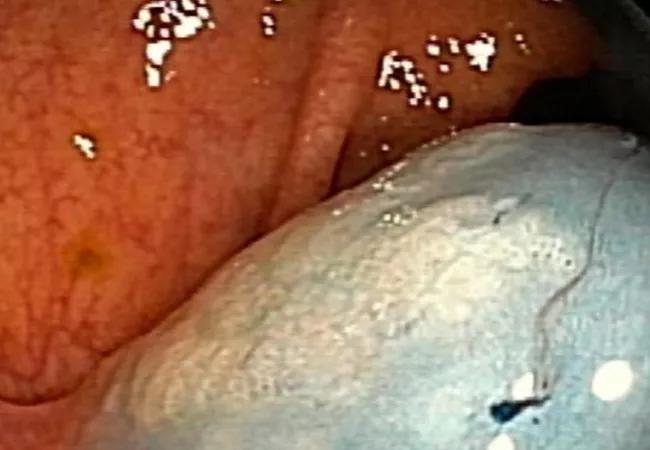Identifies key factors that could improve detection rates

Are there differences in polyp detection rates among endoscopists performing colonoscopies? Studies have found disparate results between adenoma detection rate (ADR) and endoscopist-related factors such as gender, medical school location (American or international), specialty (gastroenterology or surgery) and years in practice.
Advertisement
Cleveland Clinic is a non-profit academic medical center. Advertising on our site helps support our mission. We do not endorse non-Cleveland Clinic products or services. Policy
To shed light on this unclear issue, investigators in the Digestive Disease & Surgery Institute, which performs tens of thousands of colonoscopies annually, conducted a large, single-center retrospective study of the impact of endoscopist characteristics on the detection rates of adenomas and proximal sessile serrated polyps (pSSPs), adjusting for confounding variables that may have influenced past studies.
Learning if specific provider characteristics affect detection is important because endoscopists with a low polyp detection rate are more likely to have patients develop colorectal cancer before their next colonoscopy is due, also known as an interval cancer. “There are national benchmarks that define a high-quality colonoscopy and knowing those metrics can empower patients to make informed choices about their healthcare,” says Carol Burke, MD, Vice Chair of the Department of Gastroenterology and Hepatology and senior author of the study, who presented the findings Monday at DDW 2018. “Likewise, understanding any endoscopist-related characteristics and polyp detection rates would also be important.”
The study analyzed data from 16,089 average-risk, screening colonoscopies performed by 56 providers (gastroenterologists, 60.7 percent; surgeons, 26.5 percent; advanced endoscopists, 12.5 percent) between January 2015 and June 2017. Twenty-five percent of endoscopists were female and 25 percent were international medical graduates. The providers’ median time from training was 16.3 years and they performed a median of 267 colonoscopies per year. Sample bias was prevented by excluding endoscopists who performed fewer than 100 colonoscopies annually.
Advertisement
Provider characteristics considered in the study included endoscopist specialty, gender, location of medical school, years since fellowship, number of colonoscopies performed per year, practice setting and presence of trainee during colonoscopy. The analysis also accounted for numerous patient characteristics not considered in some studies, including age, gender, smoking status, comorbidities such as diabetes and coronary artery disease, medication use, history of cholecystectomy, and colonoscopy-related factors, including timing of procedure (month and time of day), location where colonoscopy was performed, cecal intubation rate, number of polyps found, quality of bowel preparation and withdrawal time.
Using natural language processing (NLP), the researchers were able to extract and read large amounts of textual data from the electronic medical records of the 16,089 patients that would otherwise have been difficult to access.
In the study, the average ADR was 31.3 percent (36.9 percent in males; 26 percent in females) which was above the minimum national standards suggested by the ASGE-ACG quality task force guidelines. The results of this well-adjusted analysis showed that endoscopist characteristics are not associated with ADR. Neither endoscopists’ specialty, gender, years since completion of training, practice setting, location of medical school, or incremental volume of colonoscopy were significant after adjusting for patient and procedure-associated characteristics.
Regarding pSSP detection rate (pSSPDR), the overall rate of 4.6 percent was similar to other recent studies. In the adjusted analysis, no association was found between pSSPDR and any endoscopist characteristics except for years since completion of fellowship training and annual incremental number (50/year) of colonoscopies performed. Endoscopists performing lower volumes of colonscopies and who are further from their training had significantly lower odds of pSSP detection.
Advertisement
Researchers also found a greater coefficient of variation (CV) in pSSPDR (77) than in ADR (26). The higher CV associated with pSSPDR highlights the challenges of detecting this less common and hard-to-detect polyp and the need for further research to determine effective approaches to pSSP detection. Significant evidence suggests that pSSPs are a major cause of interval colorectal cancer.
Further training to enhance the quality of pSSP detection in subgroups of endoscopists with low rates would be desirable. “Proximal SSPs are a new type of polyp that can be difficult to detect and may not have been known about when physicians were in training before 2005. Many resources are now available that would help older or lower-volume endoscopists to better understand this polyp and how to identify it,” says Dr. Burke.
Advertisement
Advertisement

Retrospective study highlights psychosocial predictors of bariatric surgery outcomes

Greater awareness among young patients is needed

Combining RFA with stenting improves survival rates, reduces post-ERCP complications

Poor response may be due to different tumor biology

Study sheds light on distant metastasis rates between upfront surgery and Watch & Wait strategies

Findings help close the knowledge gap around VTE practice patterns

Nationwide research underscores the importance of individualized treatment

Potential for non-invasive methods to transform adult celiac disease diagnoses